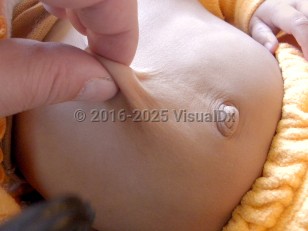- Identify clinical signs of dehydration.
- Start an intravenous (IV) line.
- Rehydrate with fluids via IV (usually normal saline or Lactated Ringer's solution) and orally if indicated.
- Diagnose the underlying cause of dehydration and treat appropriately.
Dehydration is a condition of low total body water that causes electrolyte imbalance and impairs normal organ and tissue function. Common causes are repeated vomiting, severe diarrhea, profuse sweating (often due to infection), and bleeding, frequently combined with decreased or absent fluid intake. Hospitalized or chronically ill patients are at greater risk. The aging process can contribute to lack of thirst, inability to monitor fluid intake, and swallowing difficulty. Other contributing factors may be dementia, mental health diagnoses, limited mobility and communication, and medications. Children also are at greater risk of dehydration due to increased relative total body surface area.
A diagnosis of dehydration may be suspected by percentage weight loss greater than 3% weight and changes in serum osmolality. The most common presentation of dehydration is hypernatremia.
Volume depletion (hypovolemia) can be caused by water loss or by salt and water loss. Isotonic dehydration occurs from balanced sodium and water loss, such as in fasting. Hypertonic dehydration is when fluid loss is greater than sodium loss, resulting in hyperosmolality and hypernatremia.
Signs and symptoms of mild-to-moderate dehydration include tachycardia, oliguria, orthostatic hypotension, dry mucous membranes, increased respiration, polydipsia, and altered mental status. Severe and life-threatening dehydration may additionally manifest as decreased blood pressure, sunken eyes and/or cheeks, anuria, cyanosis, shallow pulse, fasciculations, loss of consciousness, and coma.
If dehydration is not appropriately addressed, patients can ultimately experience end-organ damage secondary to decreased perfusion, including renal failure.
Risk factors for dehydration include the extremes of age, working in warm conditions or performing manual labor, athletics, and acute illness. In addition, certain medications can increase the risk for dehydration, such as diuretics. Patients who have recently traveled to or from underserved countries with concern for water contamination are also at a higher risk for dehydration secondary to diarrheal illnesses.



